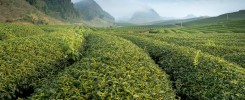“Caffeine is just a number. How it interacts with the body, with other compounds, and with your brewing ritual — that’s the real story.”
— From my years cupping teas in Yunnan and Assam
I’ve been sourcing, cupping, and trading teas for over twenty years, moving between the misty mountains of Yunnan and the sprawling estates of Assam. Over that time, I’ve noticed one recurring question from tea lovers:
“Does Pu-erh have more caffeine than black tea?”
The answer? It depends. And the reality is more subtle than most tea drinkers expect. Fresh Sheng (raw) Pu-erh can sometimes rival or slightly exceed black tea in caffeine, while aged Sheng or Shou (ripe) Pu-erh usually contains less. But what matters more than numbers is how the tea feels when you drink it.
Table of Contents
1. Caffeine Isn’t Just a Number
Most people equate tea color with strength: black tea equals high caffeine, Pu-erh equals mild. Having cupped thousands of samples over decades, I can confidently say that assumption is misleading.
Caffeine depends on several factors:
- Leaf origin and cultivar: Black teas are often from cultivated bushes selected for consistency, while Pu-erh comes from large-leaf Camellia sinensis var. assamica, often from older, even wild trees in Yunnan. Tender buds from these trees can contain surprisingly high caffeine.
- Processing: Black tea is fully oxidized, locking in caffeine and polyphenols for a quick, noticeable lift. Sheng Pu-erh ferments slowly over years; Shou Pu-erh undergoes accelerated microbial fermentation. I’ve seen fermentation slightly reduce extractable caffeine while enhancing mellow compounds, like theanine and GABA.
- Aging: Contrary to popular belief, older Pu-erh is not stronger in caffeine. It may feel “potent” due to deeper flavor and rounded body, but the actual stimulant content is often lower than fresh black tea.
2. How Caffeine Levels Compare in Practice
Based on my years of hands-on experience:
- Black tea (Assam, Darjeeling, Ceylon): ~40–70 mg per 240ml cup. Provides an immediate, sharp lift.
- Sheng Pu-erh: ~30–60 mg. Fresh spring leaves often reach the upper range.
- Shou Pu-erh: ~20–45 mg. Fermentation reduces extractable caffeine, producing gentler stimulation.
I’ve poured a fresh Sheng Pu-erh side by side with a strong Assam. Chemically, the caffeine may be similar, but the experience is entirely different: Pu-erh felt smoother, longer-lasting, and more balanced. Black tea jolted the mind immediately, Pu-erh nurtured focus and calm simultaneously.
3. Why Pu-erh Feels Different
Here’s what I’ve learned through decades of tasting: the sensation of energy is more complex than caffeine alone.
- L-theanine in Pu-erh interacts with caffeine to soften its impact.
- GABA and fermentation metabolites slow absorption, extending alertness over hours.
- Polyphenols and aging compounds enrich the body and flavor, creating a sense of “potent calm” even when caffeine is lower.
I often tell clients that Pu-erh is energizing, but not agitating. It’s the synergy of compounds that creates this subtle, layered experience — something black tea rarely achieves.
4. Brewing Transforms the Experience
From my perspective, mastering brewing is as important as choosing the right leaf:
- Gongfu-style short infusions of Pu-erh release caffeine gradually.
- Multiple infusions provide layered flavor while moderating stimulant effects.
- Water temperature matters: 90–95°C for Pu-erh, 95–100°C for black tea.
I’ve seen tea enthusiasts overbrew Pu-erh, expecting a caffeine spike similar to black tea. The result? Bitterness, not energy. Proper brewing reveals Pu-erh’s true character — balanced, rich, and mindful.
5. My Professional Verdict
After twenty-plus years in the trade, I can say this with confidence:
- Fresh Sheng Pu-erh can rival or slightly surpass black tea in caffeine.
- Shou Pu-erh and aged Sheng generally contain less caffeine but produce more sustained mental clarity.
- The experience matters more than the milligrams: Pu-erh delivers a grounded, layered alertness; black tea delivers an immediate jolt.
For me, this distinction is crucial. Tea is not just a beverage — it’s a dialogue between chemistry, craftsmanship, and human perception. Understanding how Pu-erh interacts with your body and mind enriches every cup far beyond caffeine content.

